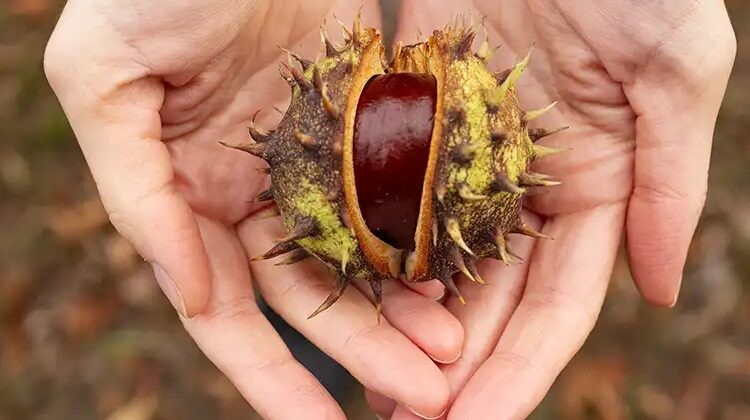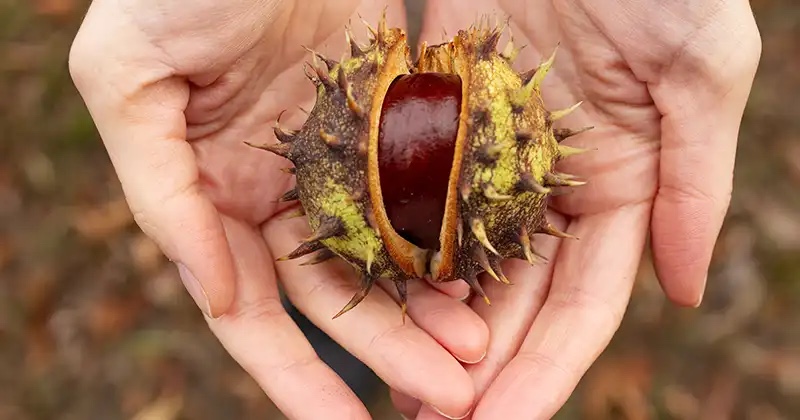
The horse chestnut tree (Aesculus hippocastanum) is a remarkable resource with numerous practical applications, particularly in traditional medicine and soap making. In this comprehensive guide, we’ll provide detailed instructions on how to make the most of horse chestnut for medicinal use and soap crafting.
Medicinal Uses:
Horse chestnut seeds and bark have been used for centuries to address a variety of health concerns. Here’s a step-by-step guide on how to harness the medicinal properties of horse chestnut:
1. Preparing Horse Chestnut Extract:
a. Harvesting Horse Chestnuts: Start by collecting fresh horse chestnuts. These are typically found in the fall when the tree’s spiky green seed capsules split open to reveal shiny brown seeds.

b. Dehusking: Remove the hard outer shell of the seeds to reveal the inner part. Be cautious, as horse chestnuts contain toxic compounds that need to be removed during the extraction process.
c. Slice and Dry: Cut the seeds into small pieces and allow them to dry. This can be done naturally by placing them in a cool, dry area, or you can use a dehydrator.
d. Prepare an Oil Extract: To create an oil-based extract, combine the dried horse chestnut seeds with a carrier oil, such as olive oil or coconut oil. Use a ratio of approximately 1 part horse chestnut to 5 parts carrier oil. Place the mixture in a glass jar and seal it tightly. Store it in a dark, cool place for 6-8 weeks, shaking the jar gently every few days to agitate the contents.
e. Strain and Store: After the infusion period, strain the oil to remove the horse chestnut seeds. Transfer the oil extract to a dark glass container with an airtight lid for storage. This oil can be applied topically to address varicose veins, hemorrhoids, and other conditions.
2. Making Horse Chestnut-Based Ointments:
a. Gather Ingredients: To create an ointment, you’ll need horse chestnut oil extract, beeswax, and essential oils (optional). Beeswax helps solidify the ointment.
b. Heat and Mix: In a double boiler, gently heat the horse chestnut oil extract and beeswax. Use a ratio of approximately 4 parts oil extract to 1 part beeswax. Stir until the beeswax is completely melted and blended with the oil.
c. Add Essential Oils (Optional): If desired, add a few drops of essential oils known for their soothing properties, such as lavender or chamomile.
d. Pour into Containers: Quickly pour the hot mixture into small containers, such as lip balm tins or glass jars. Allow it to cool and solidify.
e. Store and Apply: Seal the containers and store them in a cool, dark place. Apply the ointment topically to varicose veins, hemorrhoids, or areas with bruises or sprains.
Soap Making:
Incorporating horse chestnut into soap making can create unique and beneficial skincare products. Here’s a step-by-step guide for making horse chestnut soap:
1. Ingredients:
- Horse chestnut extract or oil
- Lye (sodium hydroxide)
- Water
- Oils and fats (e.g., coconut oil, olive oil, palm oil)
- Essential oils for fragrance (optional)
2. Safety Precautions:
- When working with lye, use protective gear, including gloves and goggles.
- Always work in a well-ventilated area.
3. Soap Making Process:
a. Prepare Lye Solution: Dissolve the lye in water. Use caution as this process can generate heat and fumes. Allow the lye solution to cool.
b. Mix Oils: Combine the various oils and fats in a large pot and heat them until they melt. Allow the mixture to cool to a suitable temperature.
c. Combine Lye Solution and Oils:Slowly pour the lye solution into the pot of oils while stirring continuously.
d. Add Horse Chestnut Extract:Incorporate horse chestnut extract or oil into the soap mixture. The amount can vary based on your preferences, but generally, 1-2 tablespoons per pound of oils is a good starting point.
e. Fragrance (Optional): If you desire fragrance, add a few drops of essential oils to the soap mixture.
f. Pour and Cure: Pour the soap mixture into molds and allow it to set for several hours or overnight. Once firm, remove the soap from the molds and let it cure for several weeks to ensure it hardens properly.
g. Enjoy: Once cured, your horse chestnut soap is ready for use. Enjoy its soothing and cleansing benefits during your daily skincare routine.
Disclaimer:
The information provided in this article is intended for educational and informational purposes only. It is not a substitute for professional medical advice, diagnosis, or treatment. Always consult with a qualified healthcare provider before using any natural remedies, including those made from horse chestnut, especially if you have underlying health conditions, are pregnant or nursing, or are taking medications.
When using horse chestnut for medicinal purposes, exercise caution and ensure that you are well-informed about the potential risks and benefits. Some parts of the horse chestnut tree contain toxic compounds, and safe preparation and dosage are critical.
Additionally, when crafting homemade products such as soap, it is essential to follow safety guidelines, especially when working with ingredients like lye. Be sure to use appropriate safety equipment and precautions to protect yourself from potential hazards.
The authors and publishers of this article do not encourage or endorse any practices that may be harmful to individuals’ health or well-being. Use the information provided responsibly and consult with healthcare professionals when necessary. Your health and safety should always be your top priority.
In summary, horse chestnut is a versatile natural resource with numerous uses, from medicinal applications to soap making. By following the steps outlined in this guide, you can tap into the remarkable healing potential and creative possibilities offered by the horse chestnut tree. As a precaution, it’s always advisable to consult with a healthcare professional when using horse chestnut for medicinal purposes, and exercise care when working with lye in soap making.
Do you like this? Share inspiration with your friends!

Leave a Reply